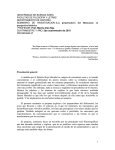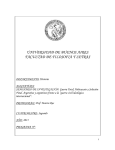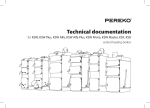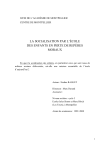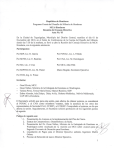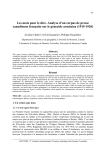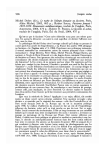Download Cronograma - Yad Vashem
Transcript
UNIVERSIDAD DE BUENOS AIRES FACULTAD DE FILOSOFÍA Y LETRAS DEPARTAMENTO DE HISTORIA SEMINARIO DE GRADO DE INVESTIGACIÓN: El Holocausto: una aproximación desde fuentes primarias. PROFESOR: Prof. Marcia Inés Ras CUATRIMESTRE Y AÑO: 2º cuatrimestre de 2009 CRONOGRAMA: - La bibliografía, fuentes y documentales pautados para cada encuentro constituyen material de consulta obligatoria para el problema a tratar en cada reunión. - El texto para la presentación individual deberá escogerse entre los que aparecen citados bajo “bibliografía complementaria” y debe convenirse con la docente. Para su preparación, se ruega consultar las pautas incluidas en el programa como “modalidad de evaluación”. -Las fechas son tentativas, sujetas al desarrollo del tratamiento de cada tema en cada encuentro. La cursada se extenderá hasta cubrir al menos los problemas esenciales de cada unidad. Horario: viernes de 15 a 19 hs. Sede: Facultad de Filosofía y Letras, Puán 480. Aula: a confirmar. Sitios en línea recomendados: www.fmh.org.ar www.ushmm.org www.college.usc.edu/vhi www.yadvashem.org I. INTRODUCCIÓN I. a . (28 de agosto) INTRODUCCIÓN Presentación general, de los objetivos del seminario y de los aspectos formales para la cursada y aprobación. Cronograma. Asignación de lecturas. Introducción a la cosmovisión nazi, volksgemeinschaft y darwinismo social. El Tercer Reich Reich 1933-1939. 1 Fuentes: Hitler, Adolfo, Mi lucha, varias ediciones, cap. 1: “En el hogar paterno” y cap. 2: “Las experiencias de mi vida en Viena”. Klemperer, Víctor, LTI [La Lengua del Tercer Reich]. Apuntes de un filólogo, Barcelona: Minúscula, 2001; cap. 6: “Las tres primeras palabras nazis”, pp. 67-72. Triumph des Willens, [El triunfo de la voluntad], Leni Riefenstahl, 1934. Selección de fuentes: El Tercer Reich 1933-1939. I. b. (4 de septiembre) INTRODUCCIÓN (continuación) Presentación de algunos de los problemas centrales y de algunas de las tesis explicativas del Holocausto. Bibliografía obligatoria: Bauer, Yehuda, “La Segunda Guerra Mundial, Shoá y genocidio”, en Nuestra memoria, año XI, nro 26, diciembre de 2005, pp. 27-35. [Versión en línea: http://www.fmh.org.ar/revista/26/index.htm] Browning, Christopher The Path to Genocide. Essays on the Launching of the Final Solution, Nueva York: Cambridge University Press, 1992, “Preface” pp. IX-XIII. Cohn, Norman, El mito de la conspiración judía mundial, Madrid: Alianza, 1983, “Prefacio”, pp. 9-14. Engel, David, El Holocausto. El Tercer Reich y los judíos, Buenos Aires: Nueva Visión, 2006; pp. 11-17. Friedländer, Saul, The Years of Persecution: Nazi Germany and the Jews 1933-1939, Phoenix, 2007; “Introduction”, pp. 1-6. Hilberg, Raúl, La Destrucción de los judíos de Europa, “Prefacio a la edición revisada”, pp. 17-20 y “Prefacio a la primera edición”, pp.21-22. Koonz, Claudia, La conciencia nazi. La formación del fundamentalismo étnico en el Tercer Reich, Barcelona: Paidós, 2005; “Prólogo”, pp.17-19. Paxton, Robert, Anatomía del fascismo, Barcelona: Península, 2005, “Un intento de explicación del Holocausto”; pp. 186-193. Traverso, Enzo, “La singularidad de Auschwitz - hipótesis, problemas y derivaciones de la investigación histórica”, en Nuestra memoria, año XI, nro 22, diciembre de 2003. [Versión en línea: http://www.fmh.org.ar/revista/22/traverso. htm ] Bibliografía complementaria: Hilberg, Raul, The Destruction of European the European Jews, Chicago: Quadrangle, 1961; ed. rev., Nueva York: Holmes and Meyer, 1985, cap. 2: “Definition by decree”, pp. 27-38. 2 Bibliografía ampliatoria: Bankier, David (ed.), El Holocausto. Perpetradores – Víctimas – Testigos”, Jerusalén: The Magnes Press, 1986. Burrin, Philippe, Hitler y los judíos. Génesis de un genocidio, Buenos Aires, Ediciones De La Flor, 1990. Cohn, Norman, El mito de la conspiración judía mundial, Madrid: Alianza, 1983 Engel, David, El Holocausto. El Tercer Reich y los judíos, Buenos Aires: Nueva Visión, 2006. Friedländer, Saul, “History, Memory, and the Historian: Dilemmas and Responsibilities”, New German Critique, No. 80, pp. 3-15 Friedländer, Saul, ¿Por qué el Holocausto? Historia de una psicosis colectiva, Barcelona: Gedisa, 2004. Friedländer, Saul, The Years of Persecution: Nazi Germany and the Jews: 1939-1945, Nueva York: Phoenix, 1997. Friedländer, Saul, The Years of Extermination, Nueva York: Harper Collins, 2007. Gilbert, Martin, Atlas of the Holocaust, Londres, 1982. Hilberg, Raul, The Destruction of European the European Jews, Chicago: Quadrangle, 1961; ed. rev., Nueva York: Holmes and Meyer, 1985. Hilberg, Raul, Perpetrators, Victims, Bystanders: The Jewish Catastrophe, 1933-1945, Nueva York: Harper Collins, 1992. Hobsbawm, Eric, Historia del siglo XX, Buenos Aires: Crítica, 1998, en especial cap. 1: La época de la guerra total”, pp. 29-61. Kershaw, Ian, La Dictadura nazi, problemas y perspectivas de interpretación, Buenos Aires: Siglo XXI Editores Argentina, 2004. Parker, R.A.C, Europa 1918-1945, México: Siglo XXI Editores, 1986. Paxton, Robert, Anatomía del fascismo, Barcelona: Península, 2005. Traverso, Enzo, The Origins of Nazi Violence, Nueva York y Londres: New Press, 2003. II. LOS PERPETRADORES II. a. (11 de septiembre) HITLER El papel de Hitler en el exterminio. Intencionalistas y estructuralistas. Nuevas perspectivas. Bibliografía obligatoria: Kershaw, Ian, La Dictadura nazi, problemas y perspectivas de interpretación, Buenos Aires: Siglo XXI Editores Argentina, 2004, cap. 5: “Hitler y el Holocausto”, pp. 131-179. Friedländer, Saul, The Years of Persecution: Nazi Germany and the Jews: 1939-1945, Nueva York: Phoenix, 1997; cap. 3: “Redemptive Anti-Semitism”, pp. 73-132. 3 Fuentes: Haffner, Sebastian, Germany: Jekyll and Hyde, Londres: Libris, 2005 [Hay traducción española: Alemania: Jekyll y Hyde. 1939, el nazismo visto por dentro, Barcelona: Destino, 2005.] “Prólogo”, pp. 11-14; cap. 1: “Hitler”, pp. 15-41. Bibliografía complementaria: Burrin, Philippe, Hitler y los judíos. Génesis de un genocidio, Buenos Aires, Ediciones De La Flor, 1990, “Introducción”, pp. 11-21 y cap. 1: “El antisemitismo hitleriano”, pp. 25-44. Burrin, Philippe, “Judeofobia e identidad nazi” en Resentimiento y apocalipsis. Ensayo sobre el antisemitismo Nazi, Buenos Aires: Katz, 2006, pp. 51-79. Dawidowicz, Lucy, The War against the Jews, Nueva York: Holt, Reinhart and Winston, 1975, “Introduction to the Tenth Anniversary Edition”, pp XIX-XXXIII y cap. 1: “The Jews in Hitler’s Mental World”, pp. 3-22. Friedländer, Saul, ¿Por qué el Holocausto? Historia de una psicosis colectiva, Barcelona: Gedisa, 2004; cap. 4: “El antisemitismo de Adolf Hitler”, pp.125-159. Hilberg, Raul, Perpetrators, Victims, Bystanders: The Jewish Catastrophe, 1933-1945, Nueva York: Harper Collins, 1992, cap. 1: “Hitler”, pp. 3-19. Kershaw, Ian, “‘Working towards the Führer’: Reflections on the Nature of the Hitler Dictatorship” en Hitler, the Germans and the Final Solution, International Institute for Holocaust Research: Jerusalén y Yale University Press: New Haven y Londres, 2008, pp. 29-48. Kershaw, Ian, “Hitler’s role in the Final Solution” en Hitler, the Germans and the Final Solution, International Institute for Holocaust Research: Jerusalén y Yale University Press: New Haven y Londres, 2008, pp. 89-116. Kershaw, Ian, The Hitler Myth. Image and Reality in the Third Reich, Oxford, 1987. [Hay traducción española: El mito de Hitler. Imagen y realidad en el Tercer Reich, Buenos Aires, 2004.], cap 9: “Hitler’s Popular Image and the ‘Jewish Question’, pp. 229-252. Lukacs, John, El Hitler de la Historia. Juicio a los biógrafos de Hitler, México y Madrid: Fondo de cultura económica, 2003; cap. 1: “Problemas historiográficos”, pp. 1551. Bibliografía ampliatoria: Bullock, Alan, Hitler. A Study in Tyrany, Harmondsworth, 1962. Burrin, Philippe, Hitler y los judíos. Génesis de un genocidio, Buenos Aires, Ediciones De La Flor, 1990. Dawidowicz, Lucy, The War against the Jews, Nueva York: Holt, Reinhart and Winston, 1975. Friedländer, Saul, ¿Por qué el Holocausto? Historia de una psicosis colectiva, Barcelona: Gedisa, 2004. Haffner, Sebastián, Germany: Jekyll and Hyde, Londres: Libris, 2005 [Hay traducción española: Alemania: Jekyll y Hyde. 1939, el nazismo visto por dentro, Barcelona: Destino, 2005.] 4 Kershaw, Ian, Hitler, the Germans and the Final Solution, International Institute for Holocaust Research: Jerusalén y Yale University Press: New Haven y Londres, 2008. Kershaw, Ian, The Hitler Myth. Image and Reality in the Third Reich, Oxford, 1987. [Hay traducción española: El mito de Hitler. Imagen y realidad en el Tercer Reich, Buenos Aires, 2004.] Kershaw, Ian, Hitler. Profiles in Power, Harlow: Pearson Educational Limited, 1991. [Hay traducción española: Hitler. Buenos Aires: Ediciones Folio, 2003] Lukacs, John, El Hitler de la Historia. Juicio a los biógrafos de Hitler, México y Madrid: Fondo de cultura económica, 2003. II. b. (18 de septiembre) “LA SOLUCIÓN FINAL” De la “solución territorial” a la “Solución Final”. 1941. Las SS, Gestapo y RSHA. La Conferencia de Wannsee. Bibliografía obligatoria: Browning, Christopher, “Nazi Policy. Decisions for the Final Solution” en Nazi Policy, Jewish Workers, German Killers, Nueva York: Cambridge University Press, 2000, pp. 26-57. Burrin, Philippe, Hitler y los judíos. Génesis de un genocidio, Buenos Aires, Ediciones De La Flor, 1990, cap. 5: “La Decisión Final”, pp. 151-175. Fuentes: “Minutes of the Wannsee Conference” en Sax, Benjamin y Dieter Kunz (eds.), Inside Hitler’s Germany. A Documentary History of Life in the Third Reich, Lexington: DC Heath, 1992. Veredicto secreto de la Suprema Corte de Policía y SS contra Maz Täubner: “None of the Jews that were killed is any great loss” en Klee, Ernst, Willi Dressen y Volker Reiss, (eds.), ‘The Good Old Days’: The Holocaust as Seen by its Perpetrators and Bystanders, Nueva York: Free Press: 1991; pp 195-207. Documental: Auschwitz and the Final Solution, Laurence Rees, 2004, episodio 5: “Matanza desenfrenada” Bibliografía complementaria: Bauer, Yehuda, “Genocide: Was it the Nazi’s original Plan?”, Annals of the American Academy of Political and Social Science, vol. 450, pp. 35-45. Breitman, Richard, “Plans for the Final Solution in Early 1941”, German Studies Review, vol. 17, No 3, pp. 483-493. 5 Browning, Christopher, “The Nazi Decision to Commit Mass Murder: Three Interpretations: The Euphoria of Victory and the Final Solution: Summer-Fall 1941, German Studies Review, vol. 17, No 3, pp. 473-481. Browning, Christopher, “Beyond ‘Intentionalism’ and ‘Functionalism’: The Decision for the Final Solution Reconsidered”, en The Path to Genocide. Essays on the Launching of the Final Solution, Nueva York: Cambridge University Press, 1992, pp. 86-121. Feierstein, Daniel, “El fin de la ilusión de autonomía. La contradicción de la modernidad y su resolución genocida” en Daniel Feierstein, (ed.), Genocidio. La administración de la muerte en la modernidad, Caseros: Universidad de Tres de Febrero, 2005, pp.133-144. Feierstein, Daniel, “Algunas discusiones en torno a las lógicas de la causalidad en los modos de explicación del genocidio nazi. Mayer, Browning, Bauman y un debate abierto sobre la cuestión del por qué del aniquilamiento” en Daniel Feierstein, (ed.), Genocidio. La administración de la muerte en la modernidad, Caseros: Universidad de Tres de Febrero, 2005, pp.133-144. Friedländer, Saul, ¿Por qué el Holocausto? Historia de una psicosis colectiva”, Barcelona: Gedisa, 2004; cap. 5: “Los creyentes”, pp. 161-189. Gerlach, Christian, “The Wannsee Conference, the fate of the German Jews, and Hitler’s decision in principle to exterminate all European Jews”, en Bartov, Omer (ed.) The Holocaust. Origins, Implementation, Aftermath, Londres y Nueva York: Routledge, 2004, pp. 43-62. Kershaw, Ian, Fateful Choices. The Ten Decisions that Changed the World 1940-1941, Nueva York, 2007 [Hay version española: Decisiones trascendentales. De Dunquerque a Pearl Harbour (1940-1941). El año que cambió la historia, Barcelona. Península, 2007], cap. 10: “Berlin/East Prussia, Summer Autumn 1941: Hitler decides to kill the Jews”, pp. 431-470. Bibliografía ampliatoria: Browning Christopher, “From ‘Ethnic Cleansing’ to Genocide to the ‘Final Solution’” en Nazi Policy, Jewish Workers, German Killers, Nueva York: Cambridge University Press, 2000, pp. 1-25. Browning, Christopher, The Origins of the Final Solution. The Evolution of Nazi Jewish Policy, September 1939-March 1942, Jerusalén, 2004. Browning, Christopher, Fateful Months: Essays on the Emergence of the Final Solution, Nueva York: Holmes & Meier, 1985. Browning, Christopher The Path to Genocide. Essays on the Launching of the Final Solution, Nueva York: Cambridge University Press, 1992. Browning Christopher, Nazi Policy, Jewish Workers, German Killers, Nueva York: Cambridge University Press, 2000. Burrin, Philippe, Hitler y los judíos. Génesis de un genocidio, Buenos Aires, Ediciones De La Flor, 1990. Hilberg, Raul, The Destruction of European the European Jews, Chicago: Quadrangle, 1961; ed. rev., Nueva York: Holmes and Meyer, 1985, en especial “Mobile killing operations”, pp. 99-153 y “Poland”, pp. 64-96. 6 Hilberg, Raul, “Perpetrators” en Perpetrators, Victims, Bystanders: The Jewish Catastrophe, 1933-1945, Nueva York: Harper Collins, 1992, en especial pp. 3102.. Filmografía sugerida: Conspiracy, Frank Pierson, 2001. II. 3. (25 de septiembre) LOS PERPETRADORES: Los Einsatzgruppen. La Wehrmacht y la brutalización de la guerra en el Frente Oriental. Los auxiliares locales. Bibliografía obligatoria: Bartov, Omer, “German soldiers and the Holocaust: historiography, research and implications”, en Omer Bartov (ed.) The Holocaust. Origins, Implementation, Aftermath, Londres y Nueva York: Routledge, 2004, pp. 162-184. Fuentes: Fragmentos de relatos de matanzas en Lituania, “Each time a victim was beaten to death they started to clap” en Klee, Ernst, Willi Dressen y Volker Reiss, (eds.) ‘The Good Old Days’: The Holocaust as Seen by its Perpetrators and Bystanders, Nueva York: Free Press, 1991; pp.23-58. Fragmentos del diario de guerra de Felix Landau, “Once again I’ve got to play general to the Jews” en Klee, Ernst, Willi Dressen y Volker Reiss, (eds.) ‘The Good Old Days’: The Holocaust as Seen by its Perpetrators and Bystanders, Nueva York: Free Press, 1991; pp. 87-106 Fragmentos del diario del Dr-SS Kremer, “There was Bulgarian Red wine and Croatian plum brandy” en Klee, Ernst, Willi Dressen y Volker Reiss, (eds.), ‘The Good Old Days’: The Holocaust as Seen by its Perpetrators and Bystanders, Nueva York: Free Press, 1991; pp 256-268. Documental: Jenseits des Krieges, [Más allá de la guerra], Ruth Beckermann, 1996. Bibliografía complementaria: Anderson, Perry, “Sobre el entramado: dos clases de hundimiento”, en Friedländer, Saul, (ed.) En torno a los límites de la representación. El nazismo y la Solución Final, Bernal: Universidad Nacional de Quilmes, 2007, pp. 93-108. Bartov, Omer “From Blitzkrieg to Total war: controversial links between image and reality”, en Ian Kershaw y Moshe Lewin (eds.) Stalinism and Nazism. Dictatorships in Comparison, Cambridge: Cambridge University Press, 2003, pp. 158-184. 7 Bartov, Omer, “Historians on the Eastern Front: Andreas Hillgruber and Germany’s Tragedy”, en Murder in our Midst. The Holocaust, Industrial Killing and Representation, Oxford: Oxford University Press, 1997, pp. 71-88. Bartov, Omer, “The Conduct of War: Soldiers and the Barbarization of Warfare”, The Journal of Modern History, vol. 64, pp. S32- S45. Bartov, Omer, “Soldiers, Nazis and War in the Third Reich”, The Journal of Modern History, vol. 63, No. 1, pp. 44-60. Browning, Christopher, “The Holocaust as By-Product? A Critique to Arno Mayer” en The Path to Genocide. Essays on the Launching of the Final Solution, Nueva York: Cambridge University Press, 1992, pp.77-85. Kershaw, Ian, La dictadura nazi, problemas y perspectivas de interpretación, Buenos Aires: Siglo XXI Editores Argentina, 2004., cap. 9: “’Normalidad’ y genocidio: el problema de la ‘historización’”, pp. 287-308. Maier, Charles, The Unmasterable Past. History, Holocaust and German National Identity, Londres, 1997, cap I: “The Stakes of the Controversy”, pp. 9-33. Bibliografía ampliatoria: Bartov, Omer, The Eastern Front 1941-1945. German Troops and the Barbarization of Warfare, Nueva York: St. Martin’s, 1986. Bartov, Omer, Hitler’s Army. Soldiers, Nazis and War in the Third Reich, Nueva York, Oxford University Press, 1992. Hirschfeld, Gehrhardt (ed.), The Policies of Genocide: Jews and Soviet Prisoners of War in Nazi Regim, Londres: Allen & Unwin, 1986 Schulte, The German Army and Nazi Policies in Occupied Russia, Oxford/Nueva York/Munich, 1989. II. 4. (2 de octubre) LOS PERPETRADORES (continuación) Los Batallones de reserva de Policía. Las motivaciones de los perpetradores “corrientes”. Bibliografía obligatoria: Browning, Christopher, “German Killers. Behavior and Motivation in the Light of New Evidence” en Nazi Policy, Jewish Workers, German Killers, Nueva York: Cambridge University Press, 2000, pp. 143-169. Fuentes: Haffner, Sebastian, Defying Hitler, Londres: Weidenfeld y Nicolson, 2002, cap. 1:, pp. 35; caps. 33-39: pp. 238-291. Klemperer, Víctor, LTI [La Lengua del Tercer Reich]. Apuntes de un filólogo, Barcelona: Minúscula, 2001; cap. 16: “En un solo día de trabajo”, pp. 143-147; cap. 18: “Creo en él”, pp. 157-178. 8 Bibliografía complementaria: Bartov, Omer, “Monstruos corrientes”, en Finchelstein, Federico (ed.), Los alemanes, el Holocausto y la culpa colectiva: el debate Goldhagen, Buenos Aires: Eudeba, 1999, pp. 101-114. Browning, Christopher, “German Killers. Orders from Above, Initiative from Below, and the Scope of Local Autonomy – The case of Brest-Litovsk”, en Nazi Policy Nazi Policy, Jewish Workers, German Killers, Nueva York: Cambridge University Press, 2000, pp. 116-142. Browning, Christopher, “Memoria alemana, interrogación judicial y reconstrucción histórica: escritura de la historia de los autores a partir del testimonio de posguerra”, en Friedländer, Saul, (ed.) En torno a los límites de la representación. El nazismo y la solución final, Bernal: Universidad Nacional de Quilmes, 2007, pp. 47-67. Browning, Christopher, Ordinary Men: Reserve Police Battalion 101 and the Final Solution in Poland, Nueva York: Harper Collins, 1992, “Afterword”, pp. 191223.. [Hay traducción española: Aquellos hombres grises. El Batallón 101 y la Solución Final en Polonia, Madrid: Edhasa, 2002, “Epílogo”, pp. 347-406.]. Browning, Christopher, “Los verdugos voluntarios de Daniel Goldhagen”, en Finchelstein, Federico (ed.), Los alemanes, el Holocausto y la culpa colectiva: el debate Goldhagen, Buenos Aires: Eudeba, 1999, pp. 115-135. Finchelstein, Federico, “El debate Goldhagen en contexto. Memorias colectivas y representaciones críticas” en en Finchelstein, Federico (ed.) Los alemanes alemanes, el Holocausto y la culpa colectiva: el debate Goldhagen, Buenos Aires: Eudeba, 1999, pp. 31-72. Hilberg, Raul, “El fenómeno Goldhagen”, en Finchelstein, Federico (ed.) Los alemanes alemanes, el Holocausto y la culpa colectiva: el debate Goldhagen, Buenos Aires: Eudeba, 1999, pp. 219-227. Mommsen, Hans, “La delicada pátina de la civilización”, en Finchelstein, Federico (ed.) Los alemanes alemanes, el Holocausto y la culpa colectiva: el debate Goldhagen, Buenos Aires: Eudeba, 1999, pp. 147-162. Westerman, Edward B.,“’Ordinary Men’ or ‘Ideological Soldiers’? Police Battalion 310 in Russia, 1942”, German Studies Review, vol. 21, No. 1, pp 41-68. Bibliografía ampliatoria: Browning, Christopher, Ordinary Men: Reserve Police Battalion 101 and the Final Solution in Poland, Nueva York: Harper Collins, 1992. [Hay traducción española: Aquellos hombres grises. El Batallón 101 y la Solución Final en Polonia, Madrid, Edhasa, 2002]. Goldhagen, Daniel J., Hitler’s Willing Executioners. Ordinary Germans and the Holocaust, Nueva York: Knopf, 1996, parte III: pp. 181-280. Finchelstein, Federico (ed.) Los alemanes, el Holocausto y la culpa colectiva: el debate Goldhagen, Buenos Aires: Eudeba, 1999. 9 III. LAS VÍCTIMAS III. 1. (9 de octubre) LAS VÍCTIMAS NO JUDÍAS La conformación del patrón criminal. El exterminio de arios con enfermedades mentales, de “asociales”, de homosexuales, de prisioneros de guerra soviéticos, de población civil eslava y polaca y de gitanos. Bibliografía obligatoria: Platen-Hallermund, Alice, Exterminio de enfermos mentales en la Alemania Nazi, Buenos Aires: La Flor, 2007. Bibliografía complementaria: Burleigh, Michael, “Psychiatry, German Society and the Nazi “Euthanasia” Programme” en Bartov Omer, (ed.) The Holocaust. Origins, Implementation, Aftermath, Londres y Nueva York: Routledge, 2004, pp. 43-62. Burleigh, Michael, El Tercer Reich. Una nueva historia, Buenos Aires: Taurus, 2003, cap. 5 “’La extinción de las ideas de ayer’: eugenesia y ‘eutanasia’”, pp. 377-441. Friedlander, Henry, “Step by Step. The expansion of murder, 1939-1941” en Omer Bartov (ed.) The Holocaust. Origins, Implementation, Aftermath, Londres y Nueva York: Routledge,, 2004, pp. 63- 71. Hilberg, Raul, Perpetrators, Victims, Bystanders: The Jewish Catastrophe, 1933-1945, Nueva York: Harper Collins, 1992, cap. 6: “Physicians and Lawyers”, pp. 65-74. Koonz, Claudia, “Ethical Dilemmas and Nazi Eugenics: Single-Issue Dissent in Religious Contexts”, en The Journal of Modern History, vol. 64, Supplement: Resistance against the Third Reich, diciembre de 1992, pp. S8-S31. Lifton, Robert J., Nazi Doctors. Medical Killing and the Psychology of Genocide, Nueva York: Basic Books, 1986. “Introduction”, pp. 3-18 y un capítulo a elección. Hay versión en línea disponible: www.holocaust-history.org/lifton/contents.shtml Lifton, Robert J. “La matanza bajo supervisión médica en Auschwitz”, en David Bankier (ed.) “El Holocausto. Perpetradores, Víctimas, Testigos”, Jerusalén: Editorial Magnes, 1986, pp. 46-79. Milton, Sybil, “Gypsies and the Holocaust”, The History Teacher, vol. 24, No 4, pp. 375387. Bibliografía ampliatoria: Burleigh Michael, The Racial State, Germany 1933-1945, Londres: Cambridge University Press, 1993. Burleigh, Michael, Death and Deliverance: “Euthanasia” in Germany, 1900-1945, Nueva York: Cambridge University Press, 1994. Foucault, Michel, Genealogía del racismo. De la guerra de las razas al racismo del estado, Madrid: La Piqueta, 1992. 10 Hirschfeld, Gehrhardt (ed.), The Policies of Genocide: Jews and Soviet Prisoners of War in Nazi Regim, Londres: Allen & Unwin, 1986. Kenrik, Donald y Grattan Puxton, Destins gitans. Des origins à la « solution finale », Paris : Calmann-Levy, 1974. Koonz, Claudia, La conciencia nazi. La formación del fundamentalismo étnico en el Tercer Reich, Barcelona: Paidós, 2005. Lifton, Robert J., Nazi Doctors. Medical Killing and the Psychology of Genocide, Nueva York: Basic Books, 1986. Tyrnauer, Gypsies and the Holocaust: a Bibliography and Introduction Essay, Montreal: Montreal Institute for Genocide Studies, 1991 Filmografía sugerida: Amén, Constantin Costa-Gavras, 2002. III. 2. (16 de octubre) LA VIDA JUDÍA BAJO DOMINACIÓN ALEMANA Trabajo forzado. Reasentamientos. Guetos. Campos de trabajo. Las estrategias de supervivencia. Bibliografía obligatoria: Browning, Christopher, “Jewish Workers in Poland. Self-maintenance, Exploitation, Destruction”, en Nazi Policy, Jewish Workers, German Killers, Nueva York: Cambridge University Press, 2000, pp. 58-88. Fuentes: Klemperer, Victor, LTI [La Lengua del Tercer Reich]. Apuntes de un filólogo, Barcelona: Minúscula, 2001; cap 25: “La estrella”, pp. 241-248; cap. 28: “El lenguaje del vencedor”, pp. 275-289. Szpilman, Wladyslaw, El pianista del gueto de Varsovia, Madrid: Turpial-Amaranto, 2001. Bibliografía complementaria: Browning, Christopher, “Nazi Guettoization Policy in Poland, 1939-1941” en The Path to Genocide. Essays on the Launching of the Final Solution, Nueva York: Cambridge University Press, 1992, pp. 28-56. Browning, Christopher, “Jewish Workers and Survivor’s Memories. The Case of the Starachowice Labor Camp” en Nazi Policy, Jewish Workers, German Killers, Nueva York: Cambridge University Press, 2000, pp. 89-115. Browning, Christopher, “Genocide and Public Health: German Doctors and Polish Jews, 1939-1941”, en The Path to Genocide. Essays on the Launching of the Final Solution, Nueva York: Cambridge University Press, 1992, pp. 145-168. 11 Browning, Christopher, “German Technocrats, Jewish Labour, and the Final Solution. A Reply to Götz Aly and Susanne Heim” en The Path to Genocide. Essays on the Launching of the Final Solution, Nueva York: Cambridge University Press, 1992, pp.59-76. Hilberg, Raul, “The Ghetto as a Form of Government”, Annals of the American Academy of Political and Social Science, vol. 450, pp. 98-112. [Hay version española en Bankier, David (ed.), El Holocausto. Perpetradores – Víctimas – Testigos”, Jerusalén: The Magnes Press, 1986, pp. 168-193.] . Bibliografía ampliatoria: Bankier, David e Israel (Yisrael) Gutman (eds.), La Europa Nazi y la Solución Final, Buenos Aires: Losada, 2005. Burrin, Philippe, Hitler y los judíos. Génesis de un genocidio, Buenos Aires, Ediciones De La Flor, 1990. Engel, David, El Holocausto. El Tercer Reich y los judíos, Buenos Aires: Nueva Visión, 2006. Hilberg, Raul, The Destruction of European the European Jews, Chicago: Quadrangle, 1961; ed. rev., Nueva York: Holmes and Meyer, 1985. Hilberg, Raul, Perpetrators, Victims, Bystanders: The Jewish Catastrophe, 1933-1945, Nueva York: Harper Collins, 1992, en especial cap. 9: “Jewish Leaders”, pp. 105117. Friedländer, Saul, The Years of Persecution: Nazi Germany and the Jews: 1939-1945, Nueva York: Phoenix, 1997. Friedländer, Saul, The Years of Extermination, Nueva York: Harper Collins, 2007. Peukert, Detlev J. K., Inside Nazi Germany. Conformity, Opposition and Racism in Everyday Life, New Haven y Londres: Yale University Press, 1987. Filmografía sugerida: El pianista, Roman Polanski, 2002. III. 3. (23 de octubre) LAS FORMAS DE RESISTENCIA JUDÍA Los judíos frente a la Solución Final. Los Judenräte. Acatamiento. Resistencia. Oposición armada. Bibliografía obligatoria: Hilberg, Raul, Perpetrators, Victims, Bystanders: The Jewish Catastrophe, 1933-1945, Nueva York: Harper Collins, 1992, “The Unadjusted”, pp. 170-185. Marrus, Michael R., “Jewish Resistance to the Holocaust”, Journal of Contemporary History, vol. 30, No 1, pp. 83-110. 12 Fuentes : Nyiszli, Miklos, Auschwitz. A Doctor’s Eyewitness Account, Greenwich: Fawcett Crest, 1969, cap. 20: pp. 93-95; cap. 22: pp. 97-99; caps. 26-28: pp. 111-128. “Escape from Treblinka” en Sax, Benjamin y Dieter Kunz (eds.), Inside Hitler’s Germany. A Documentary History of Life in the Third Reich, Lexington: DC Heath, 1992, pp. 448-455. Documental : Sobibor, 14 octobre 1943, 16 heures, Claude Lanzmann, 2001. Bibliografía complementaria: Arad, Yitzhak, “La resistencia armada judía en la Europa oriental. Sus características y problemas” en Bankier, David (ed.), El Holocausto. Perpetradores – Víctimas – Testigos”, Jerusalén: The Magnes Press, 1986, pp. 246-274. Bauer, Yehuda “Reacciones de grupos líderes judíos frente a la política nazi” en Bankier, David (ed.), El Holocausto. Perpetradores – Víctimas – Testigos”, Jerusalén: The Magnes Press, 1986, pp. 194-223 Bauer, Yehuda, “Formas de resistencia judía durante el Holocausto” en Bankier, David (ed.), El Holocausto. Perpetradores – Víctimas – Testigos”, Jerusalén: The Magnes Press, 1986, pp. 224-245. Feinberg, Nathan, “Actividades políticas judías contra el régimen nazi durante los años 1933-1939” en Bankier, David (ed.), El Holocausto. Perpetradores – Víctimas – Testigos”, Jerusalén: The Magnes Press, 1986, pp 306-331. Gutman, (Ysrael) Israel, “Los movimientos juveniles en la clandestinidad y en las rebeliones de los guettos” en Bankier, David (ed.), El Holocausto. Perpetradores – Víctimas – Testigos”, Jerusalén: The Magnes Press, 1986, pp. 275-305. Hilberg, Raul, The Politics of Memory. The Journey of a Holocaust Historian, Chicago: Ivan R. Dee, 1996, “The Thirty-Year War”, pp. 123-137. Marrus, Michael R., “Jewish Leaders and the Holocaust”, French Historical Studies, vol.15, No 2, pp.316-331. Bibliografía ampliatoria: Arendt, Hannah, “The Failure of Jewish Leadership”, en Niewyk, Donald L. (ed.) The Holocaust. Problems and Perspectives of Interpretation, Lexington: D.C. Heath and Company, 1992, pp 120-128. Bauer, Yehuda, “Forms of Jewish Resistance”, en Niewyk, Donald L. (ed.) The Holocaust. Problems and Perspectives of Interpretation, Lexington: D.C. Heath and Company, 1992, pp 129-145. Friedländer, Saul, The Years of Extermination, Nueva York: Harper Collins, 2007. Gutman, Yisrael, The Jews of Warsaw: Ghetto, Underground, Revolt, Bloomington: Indiana University Press, 1982. Hilberg, Raul, The Destruction of European the European Jews, Chicago: Quadrangle, 1961; ed. rev., Nueva York: Holmes and Meyer, 1985. 13 Hilberg, Raul, Perpetrators, Victims, Bystanders: The Jewish Catastrophe, 1933-1945, Nueva York: Harper Collins, 1992. Landau, Elaine, The Warsaw Ghetto Uprising, New York: New Discovery Books, 1992. Krakowski, Shmuel, “The Warsaw Ghetto Uprising”, en Niewyk, Donald L. (ed) The Holocaust..., pp. 145-159. Filmografía sugerida: Defiance [Desafío/Resistencia], Edward Zwick, 2008. The Grey Zone, [La zona gris],Tim Blake Nelson, 2001 Literatura sugerida: Levi, Primo: Si ahora no, ¿cuándo?, Madrid: Alianza Editorial, 1989. III. 4. (30 de octubre) LA ZONA GRIS Los judíos frente a la Solución Final. Los sobrevivientes. El testimonio. Bibliografía obligatoria: Hilberg, Raúl, “La destrucción de los judíos europeos”, Madrid: Akal, 2005, “Las operaciones de exterminio”, pp. 1061-1093. Fuentes: Levi, Primo, Los hundidos y los salvados, Barcelona: Ediciones de bolsillo, 2005. Bibliografía complementaria: Bartov, Omer, “Intellectuals on Auschwitz: Memory, History, and Truth”, en Omer Bartov Murder in our Midst. The Holocaust, Industrial Killing and Representation, Oxford: Oxford University Press, 1997, pp. 115-136. Groppo, Bruno, “Primo Levi y el problema del testimonio” en Daniel Feierstein (ed.), Genocidio. La administración de la muerte en la modernidad, Caseros: Universidad de Tres de Febrero, 2005, pp.239-256. Traverso, Enzo, La historia desgarrada. Ensayo sobre Auschwitz y los intelectuales, Barcelona: Herder, 2001, cap.VII: “Intelectual en Auschwitz. Jean Améry y Primo Levy”, pp. 181-202. Bibliografía ampliatoria: Friedländer, Saul, The Years of Persecution: Nazi Germany and the Jews: 1939-1945, Nueva York: Phoenix, 1997. Friedländer, Saul, The Years of Extermination, Nueva York: Harper Collins, 2007. 14 Hilberg, Raul, Perpetrators, Victims, Bystanders: The Jewish Catastrophe, 1933-1945, Nueva York: Harper Collins, 1992. IV. LOS TESTIGOS/ESPECTADORES (bystanders) IV. 1. (6 de noviembre) LOS TESTIGOS/ESPECTADORES (bystanders) Diferentes formas de complicidad. Anónimos pasivos. Colaboradores. Bibliografía obligatoria: Horwitz, Gordon J. “Places far away, places very near. Mauthausen, the camps of the Shoa, and the bystanders” en Omer Bartov, (ed.) The Holocaust. Origins, Implementation, Aftermath”, Londres y Nueva Cork: Routledge, 2004, pp 204218. Laqueur, Walter, “El Holocausto de Hitler: ¿quién sabía qué, cuándo y cómo? en David Bankier (ed.), El Holocausto. Perpetradores – Víctimas – Testigos”, Jerusalén: The Magnes Press, 1986, pp. 362-416. Fuentes: Klee, Ernst, Willi Dressen y Volker Reiss, (eds.), ‘The Good Old Days’: The Holocaust as Seen by its Perpetrators and Bystanders, Nueva York: Free Press: 1991. (selección a determinar) Bibliografía complementaria: Arad, Yitzhak, “La población local de los territorios de la Unión Soviética ocupados por los alemanes y su actitud ante el asesinato de los judíos”, en Bankier, David e Israel (Yisrael) Gutman (eds.), La Europa Nazi y la Solución Final, Buenos Aires: Losada, 2005, pp. 275-297. Horwitz, Gordon J., In the Shadow of Death. Living outside the Gates of Mauthausen, New York: Maxwell Macmillan International, 1990, cap. 2: “In the Shadow of the Camp”, pp. 23-54. Horwitz, Gordon J., In the Shadow of Death. Living outside the Gates of Mauthausen, New York: Maxwell Macmillan International, 1990, cap. 3: “The Castle”, pp. 5582. Horwitz, Gordon J., In the Shadow of Death. Living outside the Gates of Mauthausen, New York: Maxwell Macmillan International, 1990, cap. 4: “Into the Valley of Redl-Zipf”, pp. 83-98. Horwitz, Gordon J., In the Shadow of Death. Living outside the Gates of Mauthausen, New York: Maxwell Macmillan International, 1990, cap. 5: “Outside the Monastery”, pp. 99-123. 15 Bibliografía ampliatoria: Ascheim, Steven E., Culture and Catastrophe. German and Jewish Confrontations with National Socialism and other Crises, Hondsmills y Londres: Macmillan, 1996. Bankier, David e Israel (Yisrael) Gutman (eds.), La Europa Nazi y la Solución Final, Buenos Aires: Losada, 2005. Bankier, David, The Germans and the Final Solution. Public Opinion under Nazism, Nueva York: Oxford University Press, 1992. Bauer, Yehuda, American Jewry and the Holocaust, Detroit: Wayne State University Press, 1981. Bauer, Yehuda, American Jewry and the Holocaust, Detroit: Wayne State University Press, 1981. Friedländer, Saul, Pío XII y el Tercer Reich, Barcelona: Península, 2007. Gross, Jan T., Vecinos, El exterminio de la comunidad judía de Jedwabne, Barcelona: Crítica, 2002. Hilberg, Raul, Perpetrators, Victims, Bystanders: The Jewish Catastrophe, 1933-1945, Nueva York: Harper Collins, 1992. Horwitz, Gordon J., In the Shadow of Death. Living outside the Gates of Mauthausen, New York: Maxwell Macmillan International, 1990. Kershaw, Ian, Hitler, the Germans and the Final Solution, International Institute for Holocaust Research: Jerusalén y Yale University Press: New Haven y Londres, 2008. Marrus, Michael y Robert Paxton, Vichy France and the Jews, Stanford, 1981. Szaynok, Bozena, “El pogrom de Kielce”, en Nuestra Memoria, año XIV, nro 30, julio 2008, pp 171-175 [Versión en línea: http://www.fmh.org.ar/revista/30/NM30.pdf] Wistrich, Robert S. “El caso Jedbawbne”, en Nuestra Memoria, año XIII, nro 29, diciembre 2007, pp. 135-150. [Versión en línea: http://www.fmh.org.ar/revista/29/ Nuestra%20Memoria%2029.pdf]. Zylberman, Abraham “Los ‘Justos de la Humanidad’. Ser diferentes en un mundo indiferente” en Nuestra Memoria, año XIV, nro 30, julio 2008, pp. 147-170. [Versión en línea: http://www.fmh.org.ar/revista/30/NM30.pdf] Filmografía sugerida: Hasenjagd, [La cacería de liebres],Andreas Gruber, 1994. IV. 2. (13 de noviembre) LOS TESTIGOS/ESPECTADORES (bystanders) (continuación) Diferentes formas de neutralidad y resistencia. Rescatadores. Bibliografía obligatoria: Tych, Feliks, “Presenciando el Holocausto: diarios polacos, memorias y recuerdos” en Bankier, David e Israel (Yisrael) Gutman (eds.), La Europa Nazi y la Solución Final, Buenos Aires: Losada, 2005, pp 239-272. 16 Fuentes: Todorov, Tzvetan, The Fragility of Goodness. Why Bulgaria’s Jews Survived the Holocaust, Londres: Weidenfeld & Nicolson, 2001. (selección a determinar) Bibliografía complementaria: Kershaw, Ian, “Popular Opinion and the Extermination of the Jews” y “German Popular Opinon and the ‘Jewish Question’ 1939-1943: Some Further Reflection”, en Hitler, the Germans and the Final Solution, International Institute for Holocaust Research: Jerusalén y Yale University Press: New Haven y Londres, 2008, pp. 197-209 y 210-234. Kirchoff, Hans, “El rescate de los judíos daneses de octubre de 1943” en Bankier, David e Israel (Yisrael) Gutman (eds.), La Europa Nazi y la Solución Final, Buenos Aires: Losada, 2005, pp. 607-631. Kosmala, Beate, “El rescate de los judíos, 1941-1945. La resistencia de alemanes verdaderamente corrientes”, en Bankier, David e Israel (Yisrael) Gutman (eds.), La Europa Nazi y la Solución Final, Buenos Aires: Losada, 2005, pp. 121-141. Maurer, Trude, “Clientes, pacientes, vecinos y amigos. Relaciones entre judíos y no judíos en Alemania, 1933-1938 en David Bankier, David e Israel (Yisrael) Gutman (eds.), La Europa Nazi y la Solución Final, Buenos Aires: Losada, 2005, pp. 95-120. Bibliografía ampliatoria: Idem punto IV.1. Filmografía sugerida: Taking Sides, [Réquiem para un imperio], István Szabó, 2001. V. CONCLUSIONES (20 de noviembre) Conclusiones y balances. Presentación de un proyecto de trabajo de investigación. Bibliografía obligatoria: Bauer, Yehuda. “Día Internacional de Rememoración del Holocausto”, en Nuestra Memoria, Nuestra Memoria, año XII, nro 27, julio 2006, pp. 41-48. [Versión en línea: http://www.fmh.org.ar/revista/27/index.htm ] 17 Goldstein, Yossi, “Dilemas educativos en la enseñanza de la Shoá”, en Nuestra Memoria, año XIV, nro 30, julio 2008, pp. 171-175. [Versión en línea: http://www.fmh.org.ar/revista/30/NM30.pdf] Hobsbawm, Eric, “Cuando la pasión ciega a la Historia”, versión en línea http://www.cholonautas.edu.pe/modulo/upload/holc.pdf Traverso, Enzo, “El Totalitarismo. Usos y abuso de un concepto”, en Daniel Feierstein, (ed.), Genocidio. La administración de la muerte en la modernidad, Caseros: Universidad de Tres de Febrero, 2005, pp133-144. Vándor, Jaime, “El Holocausto y la legitimidad de su uso como tema en las artes” en Nuestra Memoria, año XIV, nro 30, julio 2008, pp. 87-93. [Versión en línea: http://www.fmh.org.ar/revista/30/NM30.pdf] Bibliografía complementaria: Dadrian, Vahakn, “Configuración de los genocidios del siglo veinte. Los casos armenio, judío y ruandés” en Feierstein, Daniel, Genocidio: la administración de la muerte en la modernidad, Caseros: Universidad Nacional de Tres de Febrero, 2005, pp. 75-120. Hobsbawm, Eric, “Barbarism: A User’s Guide”, en On History, New York: New Press, 1997, pp. 253-265. [Hay traducción española: “La barbarie: guía del usuario”, en Sobre la Historia, Barcelona: Crítica, 1998, pp. 253-266]. Bibliografía ampliatoria: Hilberg, Raul, The Politics of Memory. The Journey of a Holocaust Historian, Chicago: Ivan R. Dee, 1996. Marrus, Michael “Reflections on the Historiography of the Holocaust” en The Journal of Modern History, vol. 66, No 1, marzo 1994, pp. 92-116. Michman, Dan, “’The Holocaust in the Eyes of the Historians. The Problem of conceptualization, Periodization and Explanation” en Modern Judaism, vol. 15, No. 3, octubre 1995, pp. 233-264. Literatura sugerida: Schlink, Bernhard, El lector, Barcelona: Anagrama, 2005. Schlink, Bernhard, Amores en fuga, Barcelona, Anagrama, 2007, “La niña de la lagartija” pp. 7-49 y “La circuncisión” pp. 172-222. 18



















